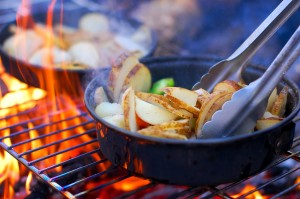Family Camping and Cooking
The first rule in feeding a family while camping is planning. Planning ahead for mealtime doesn’t just help you stay organized — it will also encourage you to pack only the necessities. It is important to create detailed menus for each day of your camping trip, and include healthy and easily prepared foods for breakfast, lunch, dinner and afternoon snacks.
 The idea here is to pack in only what you need and save time preparing meals around the campfire, always make a note of foods on your grocery list that can be chopped and cooked before you leave. Preparing meats in your home kitchen is definitely more sanitary than attempting to cut chicken or beef on a chopping block in the woods, and it will also save you from having to wash multiple utensils and cutting boards at camp.
The idea here is to pack in only what you need and save time preparing meals around the campfire, always make a note of foods on your grocery list that can be chopped and cooked before you leave. Preparing meats in your home kitchen is definitely more sanitary than attempting to cut chicken or beef on a chopping block in the woods, and it will also save you from having to wash multiple utensils and cutting boards at camp.
Look over your daily menus to build your list of essential cooking gear. Indispensable items for camping include pots and pans, a skillet, knives, a Dutch oven, flatware, paper plates, tongs and a can opener. Fireproof, nonstick cookware is also handy and will allow you to prepare meals over a fire without difficulty. When I go family camping I like to use disposable plates and forks. I do this for two reasons; first I can burn the paper dishes rather than cleaning them (which is awesome) and second, this is a sure way to return to the trail home lighter than how you came in.
It’s also important to bring along an oven mitt or a nice pair of leather gloves to keep hands safe when cooking food over the campfire. Leather and suede work gloves can serve as an oven mitt and also keep hands protected when cutting and gathering logs.
The most basic form of campfire cooking is to use direct heat. There are essentially two ways to accomplish this. The first, an old boy scouts’ trick, is to wrap food items individually in aluminum foil and place them in hot coals. It requires frequent checking, but is very effective for foods that require high heat. The second, method is simply to place a grate over an open fire and grill your food like you would on the grill in the backyard. The heat from this source is less direct, so it will likely take a little longer to cook.
Storing food properly is perhaps the most important aspect of camping. You should pack everything securely to prevent spoilage and spillage. Of course, this starts by choosing foods that are fresh, easy to prepare and safe for your family to eat. To keep food at a cool temperature, remember that block ice lasts longer than cubed ice, and wrapped frozen meats packed tightly with other food can keep the ice chest colder for longer. Watch your cooler closely, and always replace melting ice to keep meats and other perishable foods from going bad.
